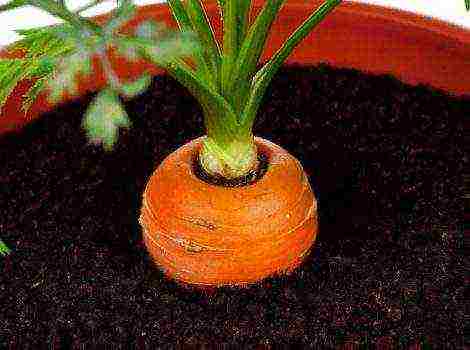Content
The royal champignon differs from the usual one, first of all, in the color of the cap - in adult mushrooms it is colored brown. Such champignons have a more pronounced mushroom taste and smell. Many people prefer royal champignons to ordinary ones, and sometimes they equate their taste with the taste of porcini mushroom.
For growing you will need:
- mushroom mycelium - 1 pack.
- straw (clean, without traces of mold) - 5 kg.
- fresh or dried poultry droppings - 1.5–2.5 kg.
- Gypsum - 0.4 kg.
- Box.
Growing method
1. Choosing a growing place. Champignons are not demanding on light. For cultivation, cellars, sheds, greenhouses with an air humidity of 60-90% can be used. If the air temperature in the room in winter is at least 10 degrees, and in summer it is not higher than 20 degrees, then it is suitable for growing royal mushrooms all year round. Otherwise, only for seasonal cultivation.
2. Preparing the compost (20 days). Soak the straw in a tank for a day or just pour plenty of water. Then lay straw and manure on the table alternating in layers (at least 3-4 layers of each component). After 5-7 days, add gypsum or alabaster to the compost, mix gently so that the outer parts of the compost get inside, and the inner parts go outside. Then mix the compost thoroughly 2 more times every 4 days, adding water if necessary. After the third break, after 3-4 days the compost is usually ready: the smell of ammonia will disappear, the straw will become soft, the compost does not stick to hands, when compressed it is slightly springy, a wet trace remains on the palm of your hand (this means that the moisture content of the compost is normal - about 60% ).
3. Laying compost and planting mycelium. Place the prepared compost in a box and tamp it lightly. Plant the mycelium in a checkerboard pattern: raise the compost and place a piece of mycelium in the resulting hole to a depth of about 10-15% of the compost thickness, then cover it with compost and press lightly.
4. Mycelium overgrowth of compost (20 days). Leave the box indoors at an air temperature of 23-25 degrees until it is completely overgrown with mycelium (about 3 weeks). As the surface dries, gently moisten the compost with a sprayer so that no water gets on the mycelium.
5. Adding the casing layer (15-20 days). Prepare the casing mixture: mix peat and chalk in a ratio of 9: 1, moisten. Pour the mixture onto the compost in a layer of 2-3 cm, moisten slightly through a spray bottle. After 3-5 days, reduce the room temperature to 14-18 degrees. The mushrooms will not grow at higher temperatures. The soil on the ridges should always be moist.
6. Fruiting. The first mushrooms will appear 15-20 days after backfilling the casing layer. From the moment the mushrooms appear, thoroughly ventilate the room, but avoid drafts.
7. Harvesting. Gently twist the mushrooms out of the soil. Places where plucked mushrooms grew should be immediately sprinkled with a casing mixture (a small amount of which should be left after filling the beds), moistened. Moistening the ridges and air, ventilating the room, picking mushrooms and adding the casing mixture is the care of the mushroom culture during the period of their fruiting.
The first harvest can be obtained 2 months after sowing. Fruiting in waves of 0.5 years.
Yield
For the entire cultivation period, about 20% of the weight of the substrate.
Release form
Mycelium of mushrooms "Royal champignon" in a substrate 60 ml.
Store in a cool dry place. Made in Russia.

Description:
Description.
Champignon is the most popular of the cultivated mushrooms.In cooking, champignons are used to cook soups, prepare sauces, season fish and meat. The high content of proteins, vitamins and minerals makes champignons a valuable food product. Champignon royal differs from the usual, first of all, the color of the cap - in adult mushrooms it is colored brown. Such champignons have a more pronounced mushroom taste and smell. Many people prefer royal mushrooms to ordinary ones, and sometimes even equate their taste with the taste of porcini mushroom.
Breeding tips.
Required: 1. Peat or soil for flowers or vegetables - 5 liters. 2. Chalk - 150 g. 3. Water - 0.8 l. 4. Compost mycelium - 60 ml. 5. Box for seedlings. 6. Film. 7. Horse manure - 5 liters, peat -2 liters, limestone or dolomite chips - 0.7 liters.
Growing and care.
1. Add 150 g of chalk, 0.8 l of water to the soil and mix thoroughly. 2. Add 60 ml of mycelium to the resulting substrate. Stir gently to avoid damaging the mycelium. 3. Place the resulting mixture in a drawer and distribute evenly. The recommended thickness of the substrate layer is 5-8 cm. 4. Cover the drawer with foil, providing a small air flow around the edges. 5. Leave the box in room conditions until it is completely overgrown with mycelium (about 3 weeks). As the substrate dries, moisten with a spray bottle. 6. After mycelium overgrowth, remove the film from the surface and transfer the substrate to a dark, humid room. 7. Cover the compost with a casing mixture, which must be prepared in advance - 4-5 days in advance. To do this, mix well-decomposed lowland peat with limestone or dolomite chips in a ratio of 3: 1 (peat can be replaced with humus soil, cleared of plant residues and weeds). During preparation, the mixture is stirred 2-3 times, moistened, then poured onto the compost with a layer of 5-6 cm, leveled and poured through a fine mesh at the rate of 1-1.5 liters of water per 1 square meter. 8. During the time that the mycelium is germinating into the casing layer (14-16 days), the temperature of the mixture is maintained at 22-24 ° C, the mixture and the room are moistened. After 8-10 days, the casing layer should be loosened to a depth of 4-5 cm. When the mushrooms begin to ripen, it is necessary to reduce the temperature in the room to 15-17 ° C, the air humidity to 90-95% and keep them at this level, constantly ventilating premises. 9. The fruiting period lasts 5-6 weeks. At this time, the mushrooms need to be collected daily or every other day, and not cut them off, but twist them at the point of growth, fill the remaining pits with a casing layer and water. The first harvest can be obtained 2 months after sowing. Fruiting in waves of 0.5 years. Productivity for the entire cultivation period is about 20% of the compost weight.
Category: Mycelium of Mushrooms
The popularity of mushroom cultivation is constantly growing every year, since such a crop can be obtained all year round. We learned the peculiarities of mushroom farming at a special mushroom farm
The cycle of professional production includes all stages: from the formation of compost to the actual receipt of fresh mushrooms. This technology is fully owned only by large mushroom farms; smaller ones, farmers, buy ready-made compost and are engaged in forcing fruit bodies - mushrooms. For an amateur who wants to grow mushrooms at home, only distillation is also available. Although, of course, it will be difficult to achieve impressive success.
And that's why:
1. For the cultivation of champignons, you need a special room without light with variable climatic characteristics
Inside special complexes, practically sealed cultivation chambers are installed, or growing rooms - lightproof rooms with an air-conditioned environment. Inside each room, in several rows, special racks are placed with a prepared prepared substrate - compost with seeded mycelium of the fungus.
Compost and mycelium
One of the essential elements of mushroom compost is grain straw.Gypsum and chicken droppings are used as additives. When cooking, the presence of pests and pathogens is completely excluded. The straw is soaked, mixed with additives and composted throughout the year. At the last stage, the mycelium is laid.
You can order from 0.2 kg of mushroom mycelium on a grain substrate via the Internet or by mail. It costs about 200-300 rubles, plus delivery. But be careful, the mycelium dies at temperatures above +33 ° C and dries completely. If the storage conditions are not respected, you will not grow anything.
2. It is necessary to change climatic parameters at different stages of mycelium development
Champignons are a rather capricious agricultural crop, and for each stage of development it is necessary to withstand a certain temperature regime and humidity. At all stages of cultivation, which takes about 3 months (a full cycle from compost to finished products), the microclimatic parameters are constantly changing in the halls. So, at one of the initial stages of growth, compost with mushrooms is kept warm and watered abundantly, pouring up to 30 liters per 1 sq. m. Literally after 2-3 days, the conditions in the chamber change (lower humidity and temperature), thereby regulating the amount of fruit ovaries formed.

Mushroom requirements:
• darkness;
• humidity;
• fatty, fertile compost.
3. Sterility of the room where mushrooms are grown
After the end of each cultivation cycle, the racks and walls are thoroughly washed and only after that a new distillation begins. Fungal infections are transmitted quickly, so the state of the compost and fungus is constantly monitored by specialists. At the first sign of infection, immediate action is taken. In addition, sources of pollution and hazards for cultivated mushrooms are the substrate workshop (gas-polluted exhaust air and the spores of pathogenic fungi contained in it) and the warehouse of the used substrate. Ideally, the production and landfill site is sufficiently distant from the main production.
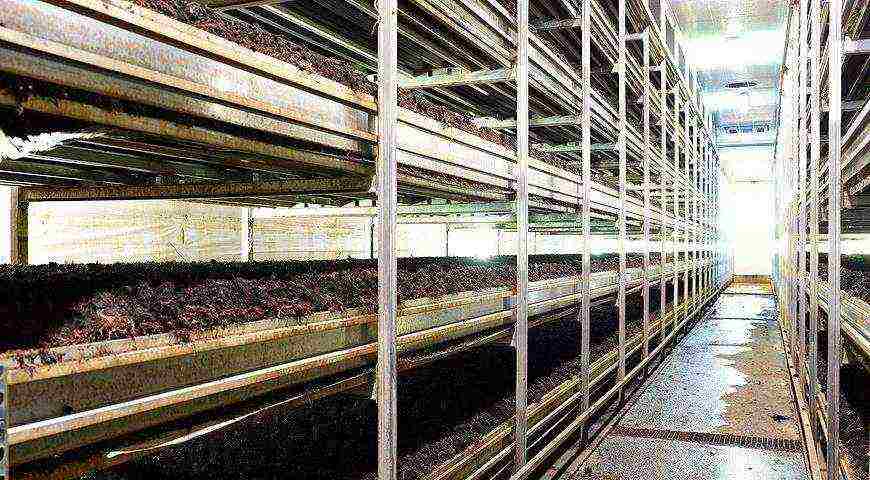
4. The mushroom harvest takes place in several waves
In 2.5–3 weeks after loading the racks, harvesting begins, which lasts about a month and includes 2 harvesting waves. The first wave of fruiting lasts about 6-7 days. The largest harvest (about 70%) falls on the first two waves. In professional farms, after the second wave, all compost is removed and taken to landfills; in private and small farms, up to 4 waves of crops are removed.
At the dacha, you can collect 8-15 kg of champignons from 1 square meter, professionals collect up to 25-30 kg.
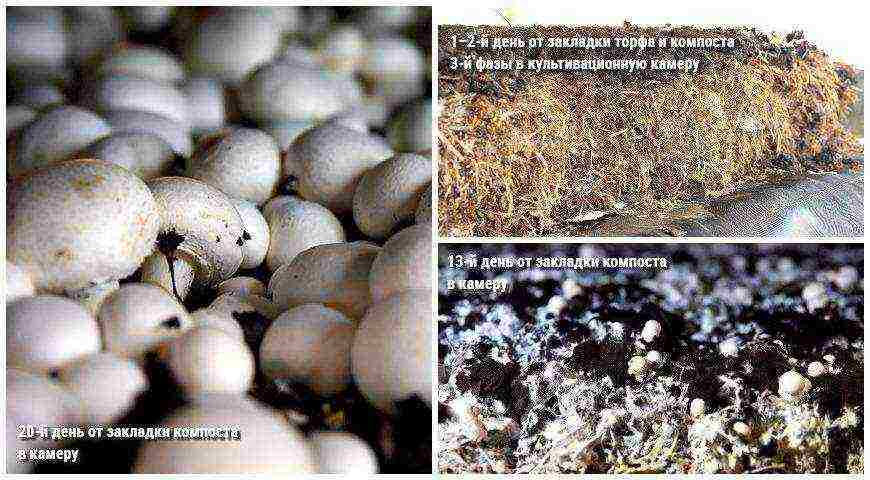
5. After harvesting, the mushrooms continue to grow
After harvesting, the mushrooms are processed in a vacuum chamber and cooled for 8-12 hours, since even cut mushrooms in the heat continue to grow, using their own nutrients. therefore, if you grow mushrooms on your own, then you need to use them right away.
Popular questions about champignons
Can champignons be eaten raw?
subject to all growing conditions, the fruit bodies of the mushrooms are not processed by anything, the collector collects them with gloves in one touch, trying to practically not touch the cap. Therefore, in the production itself, pickers and technologists eat mushrooms right from the "garden", not even washing them. Home-grown mushrooms can also be eaten right from the garden.
What are royal mushrooms and portobello? How do they differ from ordinary champignons?
Royal champignon differs from the usual color of the cap (it is brown) and more pronounced mushroom taste and aroma. Portobello is the largest mushroom with a cap diameter of 10-15 cm, so they are ideal for stuffing. Interestingly, the name “portobello” doesn’t really mean anything, it’s just a good publicity stunt designed to draw attention to these mushrooms.
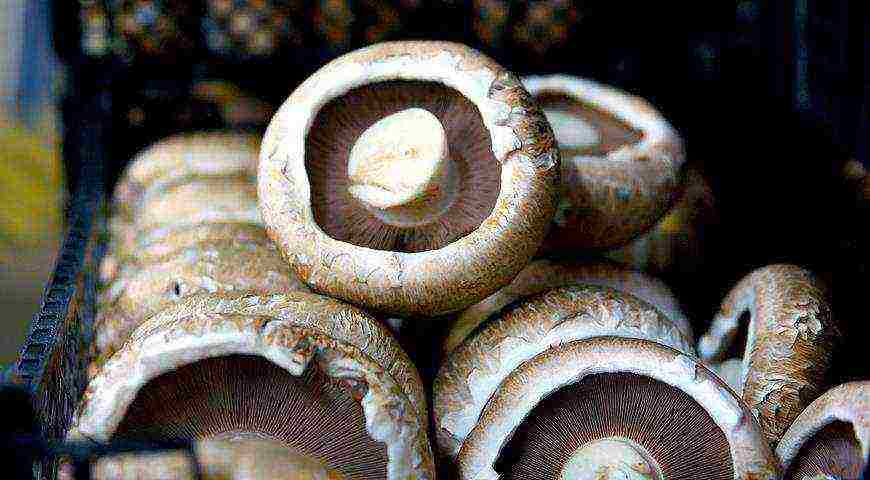
Which mushrooms are tastier?
Champignon is gaining taste and aroma gradually, an open mushroom is a mature mushroom with the most pronounced taste.Champignons with a diameter of 4–5 cm are best suited for frying and cooking soup.
Can compost after mushrooms be used on a regular farm?
Can! For mushroom production, a third stage compost is specially prepared, which is disinfected and saturated with nutrients. It is absolutely safe for plants, it can be used for mulching plantings and as a soil component for planting vegetable and flower crops.
The best spring diet for girls from mushrooms
The good news for the ladies is that there are only 20-25 kcal and 0 g of fat in one serving of champignons (4-5 medium-sized mushrooms). in addition, champignons contain nutrients, vitamins and trace elements (copper, B vitamins), antioxidants (selenium and ergothioneine) and amino acids.
At the same time, white champignons contain albeit a small amount of vitamin D, but we need it very much, especially in spring.
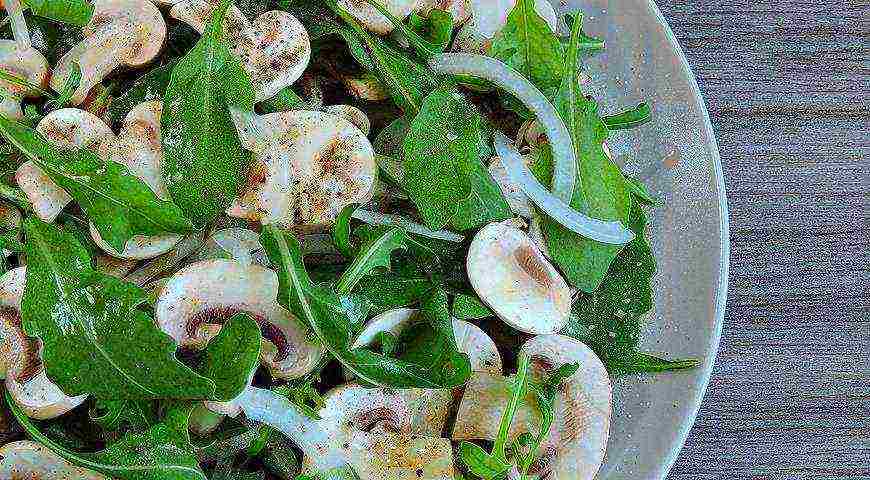
Thank you National mushroom company Kashira for help in preparing the material,
Royal champignon (Agaricus bisporus)
- Champignon double-peeled
Synonyms:
-
Two-spore champignon
-
Champignon royal
-
Champignon brown
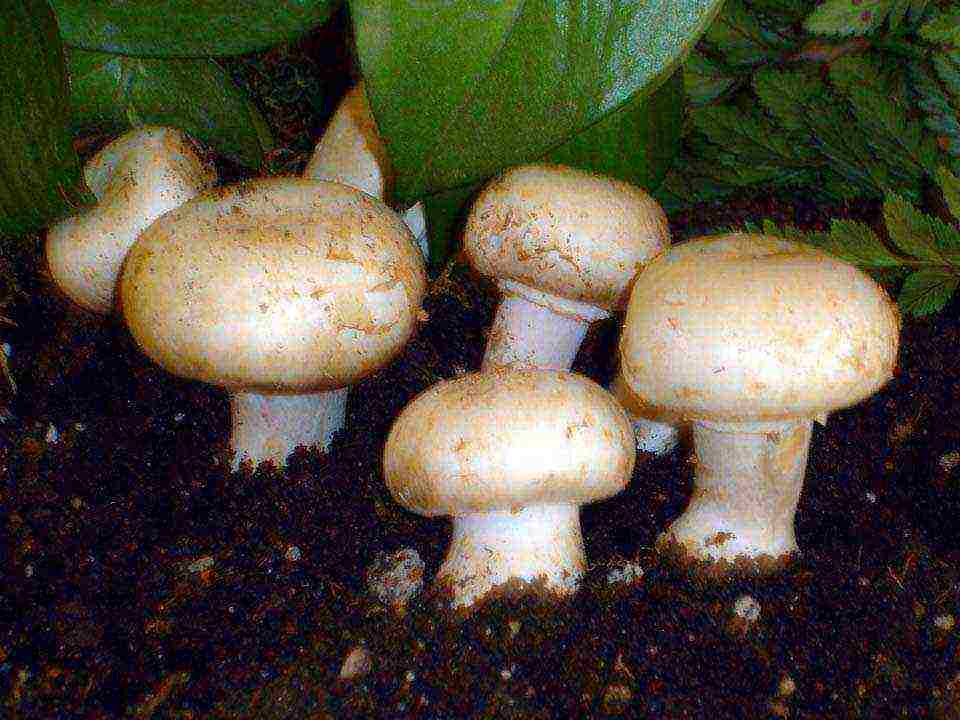
Description:
The cap of the double-stemmed champignon is hemispherical, with a curled edge, slightly depressed, with remnants of a veil along the edge, light, brownish, with brown spots, radially fibrous or finely scaly. There are three color forms: in addition to brown, there are artificially bred white and cream, with smooth, shiny caps.
The size of the cap is 5-15 centimeters in diameter, in isolated cases - up to 30-33 cm.
The plates are frequent, free, first gray-pink, then dark brown, dark brown with a purple tint.
The spore powder is dark brown.
The leg is thick, 3-8 cm long and 1-3 cm in diameter, cylindrical, sometimes narrowed towards the base, smooth, made, one-color with a cap, with brownish spots. The ring is simple, narrow, thick, white.
The pulp is dense, fleshy, whitish, slightly pink at the cut, with a pleasant mushroom smell.
Spreading:
Champignon royal grows from the very end of May to the end of September in open spaces and cultivated soil, next to a person, in gardens, vegetable gardens, in greenhouses and ditches, on the streets, in pastures, rarely in forests, on soil where there is very little or no grass , infrequently. Cultivated in many countries.
Grade:
Royal Champignon - Delicious edible mushroom (2 categories), used like other types of champignons.
Mushroom photo Champignon royal from questions in recognition:


